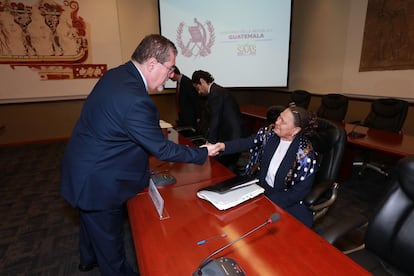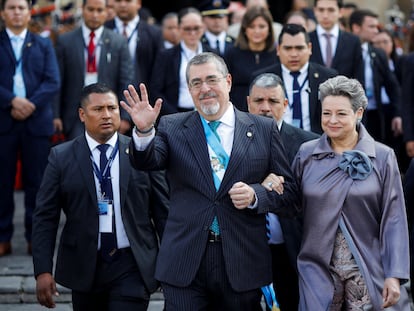Guatemala’s attorney general is the rock in the shoe of its new president
Bernardo Arévalo has failed in two attempts to see eye-to-eye with Consuelo Porras. He can’t immediately remove her, but is seeking another way to get the prosecutor out of office

The president of Guatemala, Bernardo Arévalo, and its attorney general, Consuelo Porras, briefly shook hands earlier this week before the meeting of the cabinet of ministers and government secretaries at the Casa Crema, the presidential palace. According to the president, she is responsible for last year’s attempted coup against him, which took place after Arévalo won the office amid promises to fight corruption.
A stone-faced Arévalo was standing as he took Porras’ hand. In an official photograph, she appeared to smile as she greeted him, while seated in one of the meeting room’s chairs. This, so far, is the only image of the two together. The salutation took place last Monday when, for the second time, the president attempted to meet with the prosecutor. Publicly, before taking office, he announced that he would ask for her resignation.
Arévalo’s first attempt to speak with Porras took place on January 24, but she did not show up to the meeting because, she announced, she is not “subordinate to any branch of government” and could not discuss ongoing investigations. So, the president summoned her on January 29 to attend the weekly meeting of the presidential cabinet. She attended, but eventually, citing potential “illegalities.”
The attorney general explained to EL PAÍS through her press office that the president began the session with a Council of Ministers, which she said was illegal because he had failed to first draft a governmental agreement, create a special council and establish which issues would be addressed. “It was a technicality, but simple and effective. She was able to get out of the issue because with that, she complied with the summons, with organic law,” said Javier Monterroso, former secretary general of the Public Prosecutor’s Office during the administration of Claudia Paz y Paz.
Arévalo “closed the session and began a cabinet meeting […] it did not meet the legal conditions established in the law [..] they were made aware of the legal deficiencies that made it unfeasible to hold the specific Cabinet meeting,” explained Porras, and left the room.
Shortly afterwards at a press conference, Arévalo warned that his administration would research legal actions to be taken against the attorney general. Later, Juan Luis Pataleón, the prosecutor’s spokesperson, said in a video posted on official social media accounts that Porras had sent a letter to the president inviting him to a meeting on February 7 at the Public Prosecutor’s Office headquarters to hold “a working meeting to coordinate inter-institutional efforts to benefit victims of crime.”
“I find it difficult to understand the logic of the president and his team, and I think that this week’s incidents did not bring any further clarity,” says political analyst Edgar Gutiérrez. “I believe that a good exposition of the attorney general’s shortcomings before the Supreme Court and Constitutional Court could lead to a judicial review of her actions,” said Gutiérrez, who is also a former foreign minister.
The day after the failed meeting between Arévalo and Porras in the Casa Crema, a group of legislators presented an initiative to the plenary of Congress that seeks to reform the Public Prosecutor’s Office’s organic law, and in so doing, would remove the attorney general from her position. The document was sent for processing to a working commission, which now has 45 days to analyze, correct or suggest changes and, if it arrives at a positive decision, return the initiative to the plenary for discussion. At that point, the initiative must garner at least 107 votes in favor among the 160 legislators that make up the legislative body to be approved.
Changing the strategy
Four analysts and a former attorney general, Thelma Aldana, who were consulted for this article, agree that the president should not attempt to hold any more meetings with Porras. They think that such invitations will only cause him political blowback, and that he should not make the Public Prosecutor’s Office’s invitation a priority. If necessary, he could delegate a representative or create a special council of ministers in order to get her onto his turf.
“This is a battle that is directly linked to the outcome of the elections. She is going to entrench herself and find all the legal arguments she can to prevent [being removed from] office. If he finds a way to remove her, she will file an injunction, she will ask the Courts for help, and we will continue in an absurd expansion of judicial power for a long time,” said Roberto Alejos, political analyst and former president of the Guatemalan Congress.
In 2022, the U.S. State Department included the attorney general on a document enumerating corrupt individuals in Guatemala, known as the Engel List. She and her husband are both banned from entering the country. “If the United States were to request, for example, her extradition, that level of sanction would help to diffuse this moment and provoke her immediate exit,” said political scientist Renzo Rosal.
Porras’ critics cite her attempts, as described by international and national organizations, at “undermining democracy,” and the judicial persecution she unleashed during the last two years not only against Arévalo, but also human rights defenders, journalists, judges and magistrates. Last week, the General Secretariat of the Presidency received a petition for Porras’ resignation signed by 140,000 people. Nonetheless, the prosecutor has made it clear that she will not resign, and will remain at the head of the Justice Department until the end of her term in May 2026.
When asked whether Arévalo will attend the meeting convened by Porras next week, and about what other actions he will take, the Secretariat of Social Communications of the Presidency responded that he is examining possible actions and legal paths to follow.
Sign up for our weekly newsletter to get more English-language news coverage from EL PAÍS USA Edition
Tu suscripción se está usando en otro dispositivo
¿Quieres añadir otro usuario a tu suscripción?
Si continúas leyendo en este dispositivo, no se podrá leer en el otro.
FlechaTu suscripción se está usando en otro dispositivo y solo puedes acceder a EL PAÍS desde un dispositivo a la vez.
Si quieres compartir tu cuenta, cambia tu suscripción a la modalidad Premium, así podrás añadir otro usuario. Cada uno accederá con su propia cuenta de email, lo que os permitirá personalizar vuestra experiencia en EL PAÍS.
¿Tienes una suscripción de empresa? Accede aquí para contratar más cuentas.
En el caso de no saber quién está usando tu cuenta, te recomendamos cambiar tu contraseña aquí.
Si decides continuar compartiendo tu cuenta, este mensaje se mostrará en tu dispositivo y en el de la otra persona que está usando tu cuenta de forma indefinida, afectando a tu experiencia de lectura. Puedes consultar aquí los términos y condiciones de la suscripción digital.
More information
Archived In
Últimas noticias
Most viewed
- Sinaloa Cartel war is taking its toll on Los Chapitos
- Oona Chaplin: ‘I told James Cameron that I was living in a treehouse and starting a permaculture project with a friend’
- Reinhard Genzel, Nobel laureate in physics: ‘One-minute videos will never give you the truth’
- Why the price of coffee has skyrocketed: from Brazilian plantations to specialty coffee houses
- Silver prices are going crazy: This is what’s fueling the rally










































